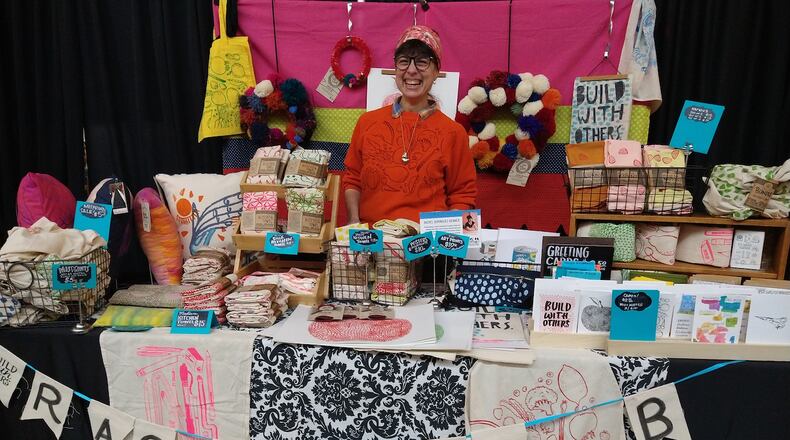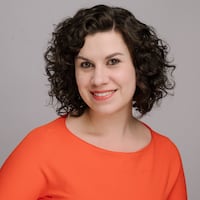“I think of my towels as accessible art. I love what people do with them — using them, or hanging it up for art, or window coverings in their traveling RV,” she said.
Dominguez-Benner, or “Rachel DB Creative” as she is known professionally, credits her Mexican heritage with a lot of her creativity.
“My abuelo — my grandfather — was a woodworker and a painter. I would make sketches and he would make them happen.”
She pulled out a wooden jewelry box as an example. Based on her childhood design, her grandfather carved and painted it with a landscape design based on Mexico’s high desert plains.
“That was the first time I experienced something that I had in my imagination turning up in the real world.”
Dominguez-Benner grew up in Lansing, Michigan and studied at the School of Art and Design at the University of Michigan.
“I still get razzed about that,” she joked.
PORTLAND TO DAYTON
Previously in Portland, Oregon, she and her partner, Ian, ran a worker-owned bicycle repair and sales shop.
She started Bundle and Stow, under which she made her own bicycle accessories, including a tool roll that connects to a bike so tire changes can be done on the road. She participated in pop-up market shows, transporting her entire booth set-up on a trailer attached to her bicycle.
Living in Portland proved unsustainable.
“We got priced out of the city. It was like everything was already done, and there were a lot of trust funds. I like to say there were artisanal pickle shops, plural.
The couple moved to Dayton in 2014.
“Ian’s grandfather was in the Air Force and had family around here. We could actually afford property.
“The people are the gems of the city. It felt like there was a lot of opportunity.”
Coming from a cooperative background, Dominguez-Benner worked as one of the main organizers of Gem City Market. She served as the Interim Marketing and Membership Coordinator.
In January 2024 she decided to stop doing consulting work and took the leap of starting her own creative business, setting a goal of producing 24 new designs in 2024.
“I have something I love. What if I put all of that energy into this? Maybe this could grow,” she thought.
A month later she was diagnosed with Stage 4 breast cancer.
“I’m not doing anything full-time now. Part of the mental health thing has been trying to reconcile how my worth as an individual is not contained within my labor output.
“I’ve always been a person who likes getting things done, so that’s been challenging. A lot of my work over the last year has been healing and resting and letting my body do its work, so I can keep being here. It’s been a lot to face your mortality.
“I’m glad that I had something that I really liked and wanted. After I got diagnosed I said, you know what, I’m still going to to do 24 designs in 2024.”
And she did.
Credit: Hannah Kasper
Credit: Hannah Kasper
PRODUCTION DAY
Every six weeks is a production day, with a full day of printing. She prints hundred of towels in each spurt.
Screenprinting is a process where ink is forced through a mesh screen onto a surface. Making certain areas of the screen impermeable to printing ink creates a stencil, which blocks the printing ink from passing through the screen. The ink that does pass through forms the printed image.
Dominguez-Benner learned screenprinting at the Penland School of Craft near Asheville, North Carolina, where she practiced collaborative large-scale yardage printing. Her background in art and graphic design shines in her confident line and lettering work.
Screenprinting began as a way to add branding to her tool rolls.
Her in-studio screenprinting process starts with hand-drawn and inked sketches on vellum paper. She uses an old school art projector to enlarge the drawing and trace it to the size of the towel she will be printing on.
She then pins the design to a cork board and uses drawing fluid to trace the design on to a blank screen. Red fluid called screen filler is coated on the screen.
“Anywhere the drawing fluid was is now blocked off. I spray it down with water after it dries, and the screen filler prevents the ink from going through.”
A prepared screen can be used to pull thousands of prints before it eventually degrades.
“When you’re in a screenprinting shop they’ll have these big machines that do one color after another. I don’t have that, so this has gone onto a drying rack and back on to the press four times. Each color is its own screen.”
It is typical to use four colors in printing. Each ink color, referred to as CYMK — cyan, magenta, yellow, and key/black — absorbs certain wavelengths of light, and when mixed, they create a variety of other colors on paper. This is the small bar of color swatches you may have noticed on the edge of a newspaper.
Dominguez-Benner uses purchased inks as well as pigments that she mixes herself from scratch. That’s her favorite part; mixing colors. She does color studies to figure out pleasing combinations and compositions, coding them by number in a sketchbook to remember the hues for future use.
Her colorful inks are stored in a metal cabinet, the doors of which are covered in cards from friends from when she was diagnosed.
She also makes paper prints, coloring books, and DIY collage kits from her painted paper which can be found at her pop-up markets.
Credit: Hannah Kasper
Credit: Hannah Kasper
TO THE MARKET
“These days I am up around 9:30. I need a lot more rest, and so I let that happen. I used to make the coffee every morning, but now Ian makes the coffee because he’s up first.
“I take my medication and then lately, I’ve been doing the NY Times word puzzles to keep my brain working and active.
“Market days are one of my favorites, because it’s when I get to interact with people and hear stories about how they like my product and how they’re using it. I’ve been really happy with the pop-up and holiday markets I’ve done. I’ll be at the Oakwood Farmer’s Market this year, two weeks out of the month, and then I’ll be up earlier.
“I will have almost certainly already packed up everything that needs to go into the car, and then Ian will load the car for me.
“I like to do sample set-ups the day before on the table, to get my layout, take photos of it so I can refer back to those when I’m setting up. I have to curate it depending on what the show is going to be.
“One of the great things about Penland is they have a dining hall and so you just show up and you get fed. I didn’t realize how much that would do for creativity. So I’ve taken that to heart and I will prep the day before by getting Bibimbap on Brown Street and I can take it to the show with me. I love that it’s gluten-free.
“I will have already picked out my outfit to minimize the amount of decisions I have to make. My market outfit is comfortable pants and one of my shirts that I made at Penland. It’s easy to relate me to my booth because I’m wearing it.
“I make sure I have my change and phone and everything I need to process transactions. I’ll drive to wherever I’m setting up, like Holly Days at the Arcade, or Pink Moon Goods, which I’ll be at for Earth Day this year.
“Then it’s unloading the car and setting up my table with my backdrop, with all the sample towels. I’ve gotten pretty good at it, so these days I have time to go visit other vendors.
“One woman came by and was like, ‘So, what makes these so special?’ I was a little taken aback, but I said, ‘Well, these are all my original illustrations, and I do the labor of the sreenprinting’, and she was like, ‘Oh, that is special!’
In Portland shows, people expect you to be the maker, but saying that out loud here really makes a difference.
“People that buy my towels buy it from the hands that made it. I think that makes it pretty special.”
Credit: Contributed
Credit: Contributed
12 PLANTS
After three hours of selling, she packs up and brings it all home again.
“I look through the list to see what sold more than other stuff, to help guide production days. The native plants have been flying off the shelves, which is so exciting.
“I’m getting ready to do a push of getting wholesale accounts.”
Her most recent series is co-branding her tea towels with the native plant nursery Tadmor Greenes, whose owner, Charlie Greene, sells plants at the 2nd Street Market.
“Charlie gives me a plant assignment — I’ve done Royal Catchfly, Virginia Bluebells, and the paw paw. These are native plants to our area. They’ve been really popular at the shows. He does wholesale orders of the towels.
“This year my goal is to get up to 12 native plants so we can do a calendar.”
CREATIVE FLOW
Credit: Hannah Kasper
Credit: Hannah Kasper
“My spouse Ian is a most excellent cook. I really like that we make good food, but also sometimes chicken strips and frozen broccoli in the oven. It’s like man, we really have to figure out how to feed ourselves again? It just never stops!”
She laughs and smiles a big grin.
“On production days I can really get on a roll, so it’s 8:30 and I can do one more run. I’m definitely winding down by 9:30. That’s a nice 12 hours of being awake and active.
“One thing over this last year was I took an online class about mark-making, and then painted all of these papers as restorative, therapeutic artmaking. I started doing collages with them. It’s something that when I feel down or stuck, it’s not as involved as trying to think of a new composition. This is something that still gets the creative flow going without having to put a lot of brain power into it. I love that they can then be made into all sorts of other things.”
MORE DETAILS
Rachel DB Creative sells her wares at “Earth Day at Pink Moon Goods” on April 19 and at the Oakwood Farmer’s Market, opening June 1.
Shop products in Dayton at Pink Moon Goods and 2nd Street Market, and in Yellow Springs at Urban Handmade.
Online: racheldb.com; @racheldbcreative on Instagram
About the Author





